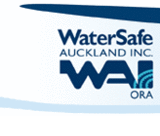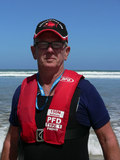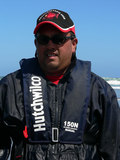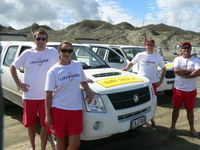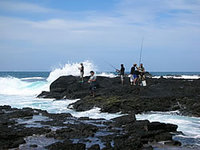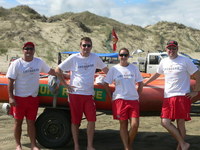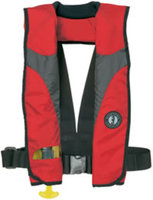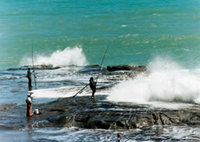Surf Rescue
Information | Rules | Millionaires Club
 |
FOR YOUR SAFETY |
|
Safety rules are important. Please read them before the contest, and keep them with you in case you need to refer to them during an emergency.
|
|
|
|
NZ Fishing News Article In the years that I have been associated with the Snapper Classic one of the most positive developments I have noticed in relation to event safety is the growing number of contestants wearing wetsuits, often combined with a lifejacket or as they are now known, personal flotation device (PFD). In my opinion there can be no safer combination for surfcasting or rock-fishing than a wetsuit and an inflatable PFD. The benefits of wearing a wetsuit far out way any other type of clothing that can be worn in the surf. Wetsuits not only reduce the risk of hypothermia but they also provide total protection from the sun, an element of protection from hooks and added buoyancy should an angler step into a hole or be swept out to sea in a rip. Although more expensive, the inflatable PFD offers a number of advantages over standard PFDs when it comes to surfcasting. These devices are lightweight, unobtrusive (to the point you hardly know you are wearing one) and most important, only buoyant when required. The problem with standard PFDs is that in chest-neck deep water the buoyancy of the PFD may actually make returning to shore more difficult when trying to wade against the powerful currents that exist on surf beaches. In this setting your full body weight is needed to keep your feet firmly on the ground. That said any PFD is better than no PFD! There has been some discussion concerning the use of waders in the surf. Common sense prevails here, but in my opinion the use of waders at this event or any surf/rock-fishing location is entirely inappropriate and potentially unsafe. Not only can waders fill with water and impede movement, but the notion they can provide buoyancy from trapped air inside them is unproven in the surf environment. Swimming a person back to shore through the surf with the added drag, or lifting them in to an inflatable rescue boat with the extra weight are two complications of waders lifeguards prefer to do without. Whilst waders do not ‘drag you under’, unlike a wetsuit they provide no buoyancy and this is a distinct disadvantage of wearing them. If you want to stay warm and safe in the knowledge that help is only a pull of a cord away, then I cannot recommend strongly enough investing in a wetsuit and an inflatable PFD for this event and indeed all your surfcasting expeditions. At the end of the day what price can you put on your safety; what price are you prepared to put on your own life? Jonathon Webber // Head Lifeguard About the author |



